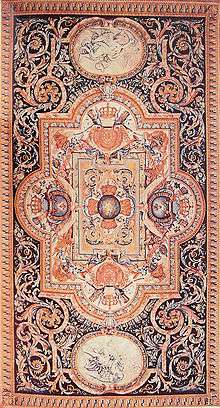Savonnerie manufactory
The Savonnerie manufactory was the most prestigious European manufactory of knotted-pile carpets, enjoying its greatest period c. 1650–1685; the cachet of its name is casually applied to many knotted-pile carpets made at other centers. The manufactory had its immediate origins in a carpet manufactory established in a former soap factory (French savon) on the Quai de Chaillot downstream of Paris in 1615 by Pierre DuPont, who was returning from the Levant.[1]
Under a patent (privilège) of eighteen years, a monopoly was granted by Louis XIII in 1627 to DuPont and his former apprentice Simon Lourdet, makers of carpets façon de Turquie ("in the manner of Turkey"). Until 1768, the products of the manufactory remained exclusively the property of the Crown, and Savonnerie carpets were among the grandest of French diplomatic gifts.[lower-alpha 1]
The carpets were made of wool with some silk in the small details, knotted using the Ghiordes knot, at about ninety knots to the square inch. Some early carpets broadly imitate Persian models, but the Savonnerie style soon settled into more purely French designs, pictorial or armorial framed medallions, densely massed flowers in bouquets or leafy rinceaux against deep blue, black or deep brown grounds, within multiple borders.
History of the manufacture
The pre-history of the Savonnerie manufacture lies in the concerns of Henri IV to revive the French luxury arts, which had collapsed in the disorders of civil violence in the Wars of Religion. French silver was being drained to the Levant and Persia for the purchase of knotted-pile carpets. Among the craftsmen the king provided with studios and workshops in the galleries of the Louvre itself, was Pierre Dupont. Dupont's La Stromatourgie, ou Traité de la Fabrication des tapis de Turquie ("Treaty on the manufacture of Turkish carpets", Paris 1632) is a prime source for information on French carpet manufacturing in the early seventeenth century (Standen).
Dupont and Lourdet fell into a quarrel that lasted into the next generation. The tapestry-workers were orphan children provided by the Hôpital de Bon Port, and Lourdet gained possession of the soap-factory buildings, while Dupont continued at the Galeries du Louvre until his death in 1640; the pile carpet manufactories both flourished, providing both Cardinal Mazarin and Anne of Austria with carpets and pile hangings, now proudly made, as the documents state, façon de France, "in the French manner".
The best of the Savonnerie carpets were completed under the new contract granted in 1664[lower-alpha 2] under the general direction of Jean-Baptiste Colbert, organized along lines similar to those employed in the Gobelins and commissioning the unequalled series of thirteen carpets for the Galerie d'Apollon and ninety-three for the Grande Galerie of the Louvre,[lower-alpha 3] which, though all but one were completed by 1683, were never used, Louis XIV's attention having become entirely fixed on Versailles, while the Grand Galerie was now used for displaying maps and plans of fortifications rather than royal levées. Nevertheless, a fortune was spent on the carpets, which were paid for at the rate of 165 livres per aune, which measured 118.8 square centimeter/46 and a half square inches. The designs were from the king's painter Charles Le Brun, realized as full-scale cartoons by two painters from the Gobelins; Le Brun was carrying out ceiling paintings in the same galleries. Weaving began in 1668 and the first carpets for the Grande Galerie were delivered towards the end of that year (Wrightsman catalogue, no. 277). Some thirty-five complete carpets remain in the French Mobilier National today.

In its heyday, the Savonnerie took sixty orphans aged ten to twelve and apprenticed them for six years, at the end of which term, one would be granted the maîtrise while the others would remain journeymen. The children were taught the art of design as well, a painter from the Académie coming once a month to inspect their projects. Later, under the financial stringencies ensuing from the wars of Louis XIV, the Savonnerie fell into eclipse, its management combined with that of the Gobelins under the direction of the architect of the Bâtiments du Roi, Robert de Cotte, its workers often unpaid, its looms frequently idle, though in 1712 it was made a Manufacture Royale.
During the 18th century attempts were made to update the manufactory's often retardataire designs, lightening and brightening the colors and introducing Rococo elements. In the later eighteenth century, Savonnerie produced panels for screens and firescreens and some wall-hangings. The Revolution saw the factory's nadir; royal crowns, cyphers and fleurs-de-lys were cut from carpets that remained in storage as insignia of féodalité. The revival of the Savonnerie is due to the patronage of Napoleon, who commissioned carpets after 1805 in the Empire style. New cartoons were designed by Percier and Fontaine and the old stock of drawings made their way into the collections of the new Louvre Museum. In 1825, the Savonnerie was incorporated with the Gobelins Manufactory, and its independent existence came to an end.
See also
Notes
- ↑ The ambassadors of Russia, Spain, Denmark, Siam and even an unauthorized "ambassador" from Persia were all presented with Savonnerie carpets (Standen).
- ↑ The contract was to Lourdet alone; Louis Dupont continued to occupy his royally sponsored workrooms at the Louvre until 1671, when his workshop was established at the Savonnerie, independent of that run there by Lourdet's widow (Standen).
- ↑ The Grande Galerie du Bord de l'Eau that is the Louvre's present long paintings gallery.
References
- ↑ Blagdon, Francis William. Paris as it was and as it is, or, A sketch of the French capital. p. 512. Retrieved 11 June 2011.
- Madeleine Jarry, 1966. The Carpets of the Manufacture de la Savonnerie.
- Edith Standen in F.J.B. Watson, 1966. The Wrightsman Collection, vol II, nos 275–8 and Appendix (New York: Metropolitan Museum of Art)





